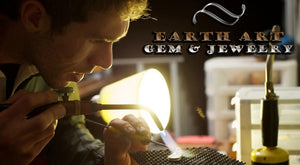Turquoise is still a very popular stone, and was used in great abundance throughout the 70's in hand made Native American style jewelry. It is still a prized stone among tribesman and in many other cultures.
Turquoise is mined in two primary areas: The southwestern United States and in China. The turquoise mined in the US is often individually named for the mine that it originated from, such as Sleeping beauty, Bisbee, Kingman or No.7. To this day, most mines are owned and operated by individuals or families, using small scale rock harvesting methods. There is also still a lot of vintage material on the market, some still in its raw form. Knowing the exact history and origin of a stone can increase its appeal and value.
Turquoise is also considered one of the modern birthstones for December.
There are dozens upon dozens of different types of turquoise, mostly named from where they came, but there are also a lot of turquoise look-a-likes. Here are a few:
Dyed howlite, dyed Magnesite, "White Buffalo Turquoise" and even plastic or resin cast turquoise.
White buffalo turquoise is not actually turquoise. It is dolomite and is naturally white and has a similar veining as natural turquoise and is found in Nevada. It is is sometimes confused with howlite or magnesite due to its white color and black veining but cna be differentiated with a hardness test. Dolomite is harder with a hardness of 5 while the other two tend to be around 3-4.
Here is a video about how to test your own turquoise at home:
https://youtu.be/hMpnNm0azYg

 Alexandrite
Alexandrite Amethyst
Amethyst Aquamarine
Aquamarine Citrine
Citrine Diamond
Diamond Emerald
Emerald Garnet
Garnet Opal
Opal Pearl
Pearl Peridot
Peridot Ruby
Ruby Sapphire
Sapphire Tanzanite
Tanzanite Topaz
Topaz Tourmaline
Tourmaline Turquoise
Turquoise Zircon
Zircon